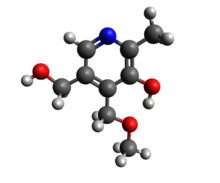Ginkgotoxin

| |

| |
| Names | |
|---|---|
| Preferred IUPAC name
5-(Hydroxymethyl)-4-(methoxymethyl)-2-methylpyridin-3-ol | |
| Other names
4'-O-methylpyridoxine; 4-O-methylpyridoxine
| |
| Identifiers | |
3D model (
JSmol ) |
|
| ChEBI | |
| ChEMBL | |
| ChemSpider | |
PubChem CID
|
|
CompTox Dashboard (EPA)
|
|
| |
| |
| Properties | |
| C9H13NO3 | |
| Molar mass | 183.207 g·mol−1 |
| Hazards | |
| GHS labelling: | |

| |
| Danger | |
| H300, H330 | |
| P260, P264, P270, P271, P284, P301+P310, P304+P340, P310, P320, P321, P330, P403+P233, P405, P501 | |
Except where otherwise noted, data are given for materials in their standard state (at 25 °C [77 °F], 100 kPa).
| |
Ginkgotoxin (4'-O-methylpyridoxine) is a
Occurrence
Seeds and phytopharmaceuticals derived from the plant Ginkgo biloba are
Ginkgotoxin is found in the seeds and, in lesser amounts, in the leaves of Ginkgo biloba. The seeds can be consumed as is and the leaves can be used to prepare the dietary supplements. Analyses of raw seeds from eight different location in Japan by
Ginkgotoxin-5'-glucoside is a derivative of ginkgotoxin that possesses a
Ginkgotoxin can also be found in other plants of the genus Albizia.[3] However, these plants have no known dietary use for humans, so their production of ginkgotoxin is of lesser concern.
Biosynthesis
Ginkgotoxin is the 4'-O-methyl derivative of vitamin B6 (
Toxicity
A few cases reported poisoning from commercially available products. The consumption of seeds represent a greater concern. Overconsumption of Ginkgo biloba seeds, especially by children, can result in
Ginkgotoxin is structurally related to vitamin B6. It is suspected that ginkgotoxin interferes with the synthesis of the vitamin by decreasing the activity of
References
External links
 Media related to Ginkgotoxin at Wikimedia Commons
Media related to Ginkgotoxin at Wikimedia Commons
